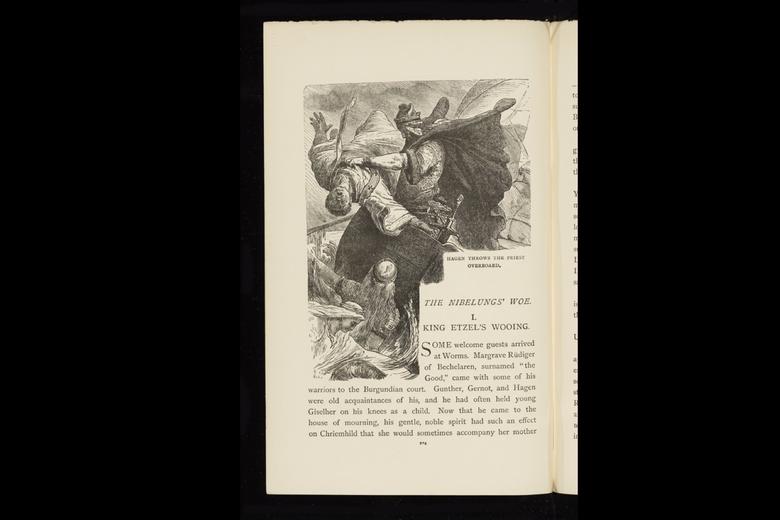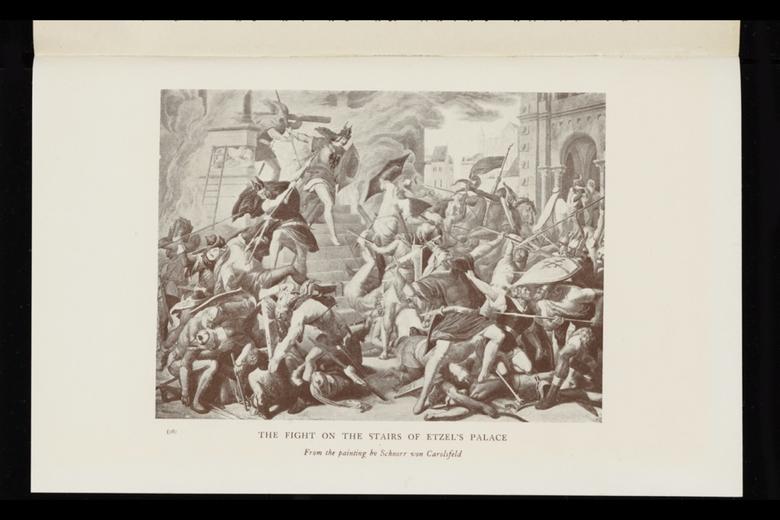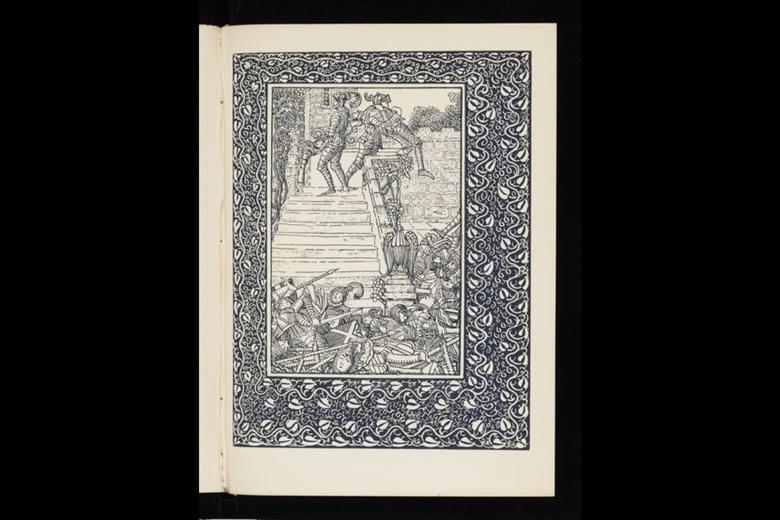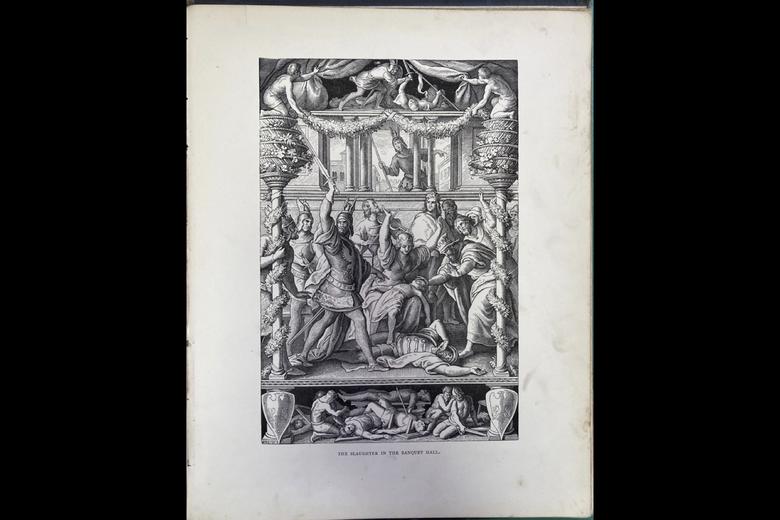Panel 1: Doomed Heroes
Here we see heroes who will not go on to triumph, whether they are to meet their deaths in a blaze of glory, or as a result of betrayal. Two images show Hagen’s cowardly murder of the great hero, Siegfried, whose strength and invulnerability mean that he can only be destroyed through deception. One image shows Hagen’s desperate and violent attempt to disprove a dreadful prophecy that all but one of the Burgundians are doomed, should they continue with their journey. The other images depict the Burgundian warriors, fighting unrelentingly in the face of certain death. This panel shows courage and pathos, bravery and treachery, and it tells a complex tale: Hagen is the aggressor in several of the images, yet one of the valiant warriors fighting against the odds in the others.
The Nibelungenlied was viewed as the German national epic, but anglophone writers often also staked their own claims to it. The underdog’s struggle against immeasurable odds is a frequent feature of national narratives, including in this country, and we see here warriors depicted at their defining moment, characterized not necessarily by their virtues or achievements, but by their most desperate experiences.
Siegfried's murder
Siegfried's murder: Margaret Armour, 'The Fall of the Nibelungs', illustrated and decorated by W.B. MacDougall, London, 1897.
‘As Lord Siegfried bent to drink from the fountain, Hagen shot him through the cross on his back, so that his heart’s blood sprang from the wound on to Hagen’s clothes. A hero never did a worse deed.’
Nibelungenlied, stanza 981
Neither the medieval author nor the later adapters and illustrators hid their feelings: the treacherous stabbing in the back of an unarmed hero was a uniquely infamous and shameful action.
|
Exhibit 1:
‘While Siegfried drank the cool, clear water, Hagen stabbed him’
Mary MacGregor, Stories of Siegfried, told to the children, with pictures by Granville Fell, London, c. 1908.
|
Exhibit 2:
Margaret Armour, The Fall of the Nibelungs, illustrated and decorated by W.B. MacDougall, London, 1897. |
|
Private loan |
The Bodleian Libraries, University of Oxford: 28849 e.60 |
Hagen attempts to drown the priest
‘Hagen throws the priest overboard’ Epics and Romances of the Middle Ages, adapted from the work of Dr W. Wägner by M.W. MacDowall, and edited by W.S.W. Anson, London, 1884, 2nd edn.
‘I wanted to prove the wild water women lied, when they said none of us but the chaplain would return home, so I wanted to drown him’
Nibelungenlied, stanza 1589
Hagen, Siegfried’s killer, attempts to disprove a prophecy that only the chaplain will return home alive by ensuring he doesn’t. The priest survives, and Hagen and his comrades press on, knowing their fate. The image captures both aggressor’s and victim’s despair.
|
Exhibit 1:
‘Hagen throws the priest overboard’ Epics and Romances of the Middle Ages, adapted from the work of Dr W. Wägner by M.W. MacDowall, and edited by W.S.W. Anson, London, 1884, 2nd edn. Images based on illustrations by Hermann Vogel and reproduced from Wilhelm Wägner, Deutscher Heldensagen, Leipzig and Berlin, 1881.
|
|
The Bodleian Libraries, University of Oxford: 930 e.13 |
Battle at the Huns' court
‘The fight on the stairs of Etzel’s palace’ Donald Mackenzie, Teutonic Myths and Legends, London, c. 1912.
Margaret Armour, The Fall of the Nibelungs, illustrated and decorated by W.B. MacDougall, London, 1897.
‘The slaughter in the banquet hall’ Lydia Hands, Golden threads from an ancient loom. Das Nibelunglied, adapted to the use of young readers with fourteen wood engravings by Julius Schnorr, of Carolsfeld, London, 1880.
‘Then they took 7000 corpses to the door, and threw them outside, where they fell down the stairs’
Nibelungenlied, stanza 2013
The frantic battle at the Hunnish court showcases the complexity of the Nibelungenlied. Characters like Hagen, who have behaved shamefully, now fight with honour against horrific odds. The death toll is such that even the more graphic of these two images falls short of its scale.
|
Exhibit 1:
‘The fight on the stairs of Etzel’s palace’ Donald Mackenzie, Teutonic Myths and Legends, London, c. 1912. Image from the fresco by Julius Schnorr von Carolsfeld. |
Exhibit 2:
‘Kriemhild with the head of Gunther’ Margaret Armour, The Fall of the Nibelungs, illustrated and decorated by W.B. MacDougall, London, 1897.
|
Exhibit 3:
‘The slaughter in the banquet hall’
Lydia Hands, Golden Threads from an Ancient Loom. Das Nibelunglied, adapted to the use of young readers with fourteen wood engravings by Julius Schnorr, of Carolsfeld, London, 1880. The woodcuts are a selection from Pfizer (1843).
|
|
The Bodleian Libraries, University of Oxford: 38.M.13 |
The Bodleian Libraries, University of Oxford: 28849 e.60 |
Private loan
|








